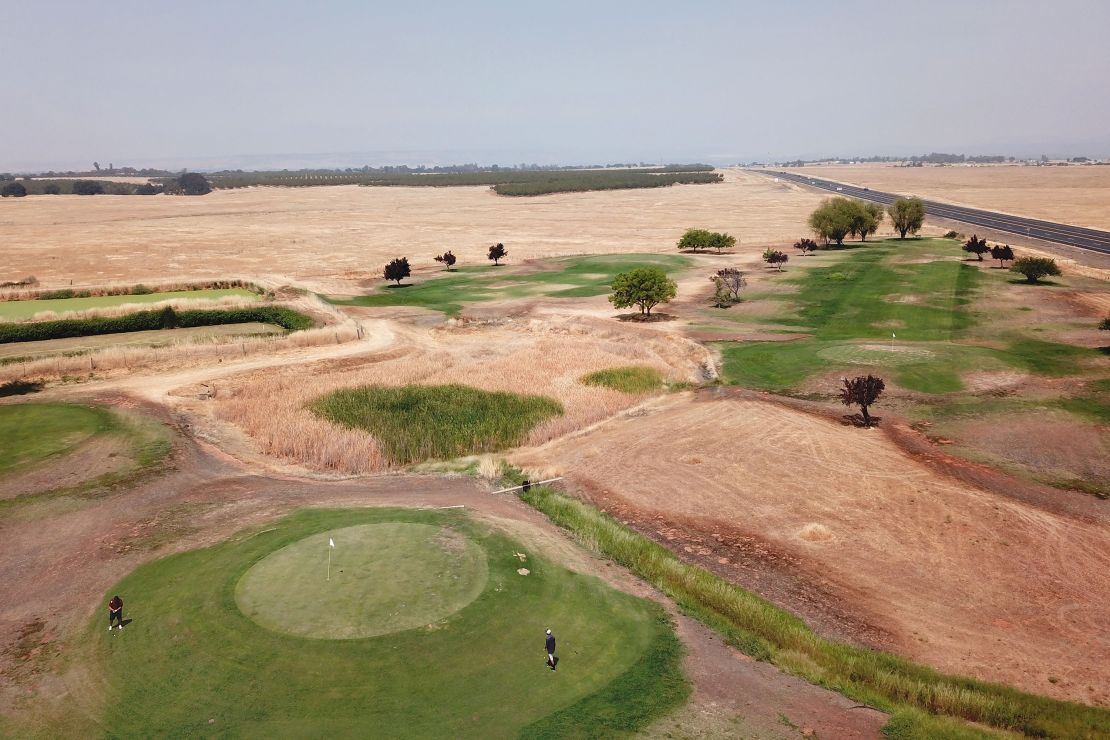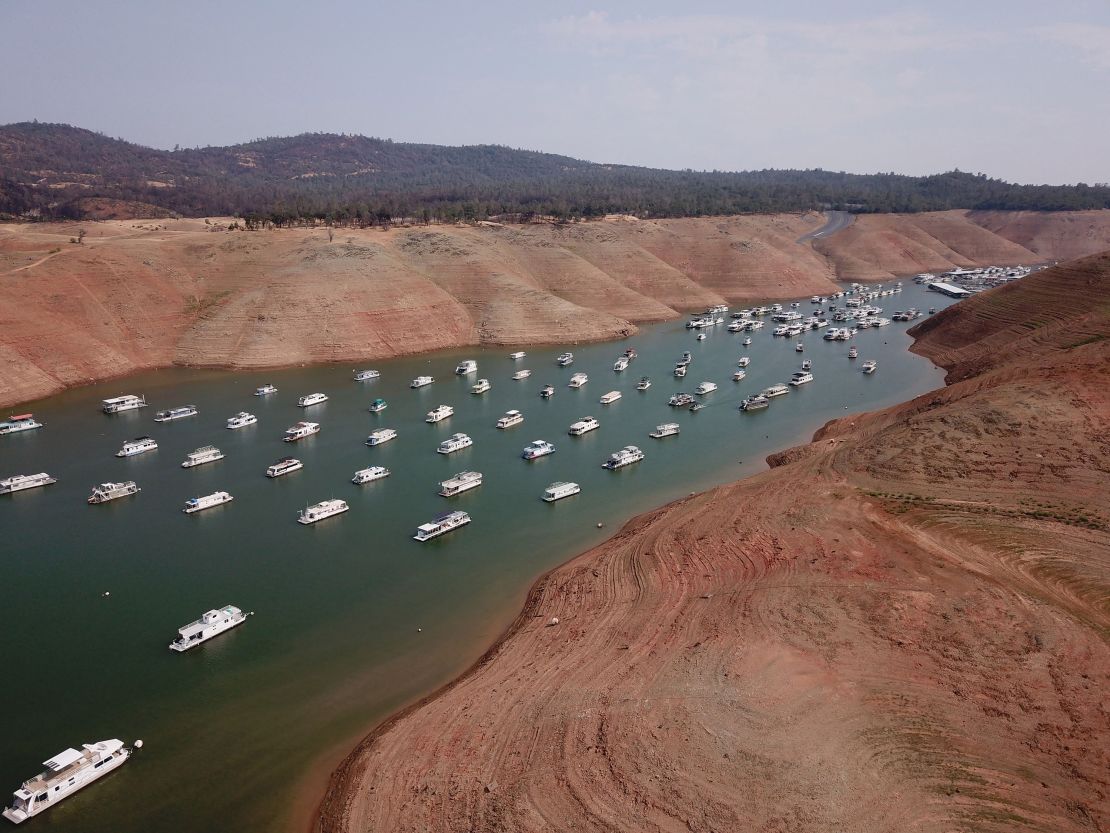The dire drought that has been smothering much of the West for months got even worse this week, with areas in California and the Pacific Northwest seeing an expansion of drier conditions, which have fueled menacing wildfires across the region.
“There isn’t a ‘normal’ anymore. We need to be prepared for anything,” said Norm McDonald, the incident commander for the Bootleg Fire in Oregon, the nation’s largest blaze, which was ignited in early July and was only 53% contained as of Friday.
Nearly half of California is suffering exceptional drought, which is the worst category designated by the US Drought Monitor.
Last week, a little over a third of the state was under that category. Now, nearly 14.5 million people are impacted, a more than 50% increase from last week, according to the monitor, which is produced through a partnership between US government agencies and the National Drought Mitigation Center at the University of Nebraska-Lincoln.
“Further expansion of moderate to exceptional drought was introduced in parts of California and the Northwest, as agricultural, wildfire, and water-supply impacts continued to mount,” the center said.
Northern California, western Oregon, and Washington are under heat alerts with triple-digit heat causing sweltering conditions, CNN Meteorologist Robert Shackelford said.
“There are also dry thunderstorms across the Pacific Northwest coast, with dry thunderstorms potentially sparking new fires,” Shackelford said. “Dry thunderstorms threat will be there until at least Saturday but may be extended later into the weekend and into next week.”
California’s wildfire season has been devastating, and the exacerbated drought conditions are bound to make it even worse. Wildfires in California have scorched close to four times the number of acres destroyed at this time last year.
So far, five active large wildfires in the state have burned 361,023 acres, with the largest – the Dixie Fire – destroying 240,595 acres alone. Its containment was at 24% Friday.
The fire is the 11th largest in state history.
The worsening drought is also affecting Oregon. Nearly one-fourth of the state is under exceptional drought, a record high in the state, which makes it harder to control the massive Bootleg Fire.
“Despite the recent rain, fire activity picked up yesterday,” according to a statement on InciWeb. “Fire activity increased as the warm day dried out the fire faster and wind gusts were stronger than expected.”
The Bootleg Fire has scorched 413,545 acres while destroying more than 400 structures and at least 342 vehicles in its way, according to InciWeb, the national clearinghouse for wildfire information.
“As we move out of normal climatological range, previous experience is less relevant,” said Fire Behavior Specialist Chris Moore. “The rain that we got will not put the fire out. Spotting will become more of an issue as fuels dry out again.”

Biden and Harris to meet with governors to talk about raging wildfires
Overall, the dozens of large active wildfires have burned 1.74 million acres across 13 states, according to the National Interagency Fire Center. For the year to date, all fires in the US have burned about 3 million acres, NIFC said.
President Joe Biden met virtually Friday with a bipartisan group of governors to discuss what he called the “urgent matter” of worsening wildfires and called for close coordination between the state and federal governments as wildfire season approaches.
“We’re in a for a long fight yet this year and the only way we’re going to beat those challenges is by working together. Wildfires are a problem for all of us and we have to stay closely coordinated and do everything we can,” Biden told the governors.
Nevada and California are home to the Tamarack Fire, which has burned 68,696 acres as it straddles the states’ border. It was 65% contained Thursday.
“We need help. We need help on the federal side. We need more people coming in. We need more resources. We need more air support. We need more people and more boots on the ground in order to make this a more fair fight in terms of fighting these fires,” Nevada Gov. Steve Sisolak said at a joint news conference with California Gov. Gavin Newsom on Wednesday.
The governors’ meeting with Biden was to discuss funding and investing in wildland firefighters, including increasing pay for federal firefighters and extending hiring for temporary firefighters. In June, Biden signed an executive order that raised the minimum wage for federal firefighters to $15 an hour.
The group will also talk about efforts to strengthen wildfire prevention, preparedness, mitigation and response efforts, and will hear how an early and severe wildfire season is affecting residents and land in the states.

Wildfires are a global issue
It’s not just the US facing the devastating impact of the climate crisis, which is making deadlier and more destructive wildfires the new normal.
Wildfires have spread in southern Europe, including on the Italian island of Sardinia, where nearly 1,000 people fled their homes due to encroaching flames.
The island’s local government declared a state of emergency, calling the fires a “disaster without precedence.”
And in Greece, 50 fires were ignited between two days this week as the country grappled with a stubborn heatwave.
Meanwhile in Russia, the far eastern region of Yakutia has seen 6,424,739 million acres destroyed in wildfires since the beginning of the year, according to figures published by the country’s Aerial Forest Protection Service.
In Canada, hundreds of wildfires are so intense that British Columbia officials sought Mexican firefighters last week to help combat the raging flames, officials said.
CNN’s Ella Nilsen, Cheri Mossburg, and Brandon Miller contributed to this report.


